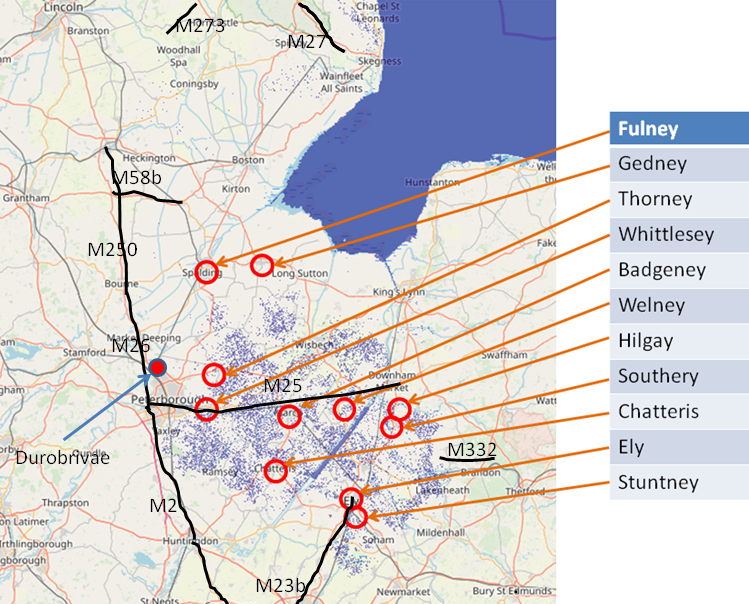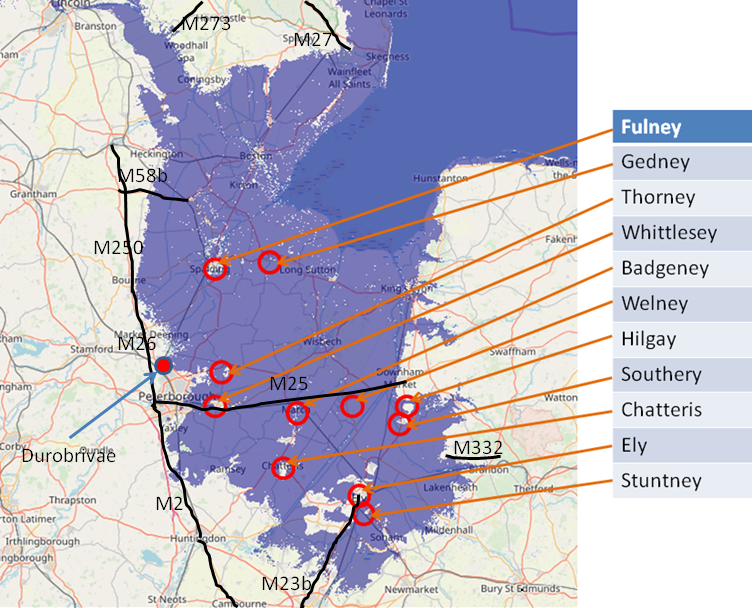|
| Landscape - Was the high tide level in Saxon times in the Wash 4 to 5 metres higher ? |
|---|
| |
|---|
Table of Contents
|
|---|
|
| |
|---|
Was the high tide level in Anglo Saxon times higher than today ▲
|
|---|
This page is designed to show why I believe that the high tide level was 4 to 5 metres higher than today, in about 450AD
(early Anglo Saxon times)
So we will start by looking at the Saxon place names which refer to islands these places are all derived from the Saxon
word æg meaning an island, which has been shown to refer to modern place names starting in eg, ending in ay, et, ey,
ly, ney, sea, sey, ye , is, or contain the snippet eye or island.
So lets take a look at the Wash in Eastern England and see if we can make it and the surrounding island villages into
islands by raising the high tide level. The following images are derived from Open Streetmap with the high tide level
overlays provided by Alex Tingle from http://flood.firetree.net.
|
| |
|---|
The Wash in Eastern England ▲
|
|---|
Lets take an area I don't really know, the Wash and see if the Pevensey arguement applies- click here if you would like
to see a similar argument applied to an area I do know, the Pevensey Levels in Sussex.
I think this is a valid argument for a 5 metre high tide level so we need to overlay all our maps with this and see what
this shows, the following maps show what effect this would have on the Wash. As you will see , most of the river valleys
would have been accessible from the sea, and large areas would have been under water.
The 'Time Team' carried out a dig at 'Bawsey st Peter' in Norfolk and found a causeway to the island there, this also
ties in with the increase in high tide level by about 5 metres, the Saxon name Bawsey either means 'Pasture Island' or
'Boars Island' so more evidence that the 5 metre mark is valid.
Ivan D Margary plotted one of the Roman Roads in South Lincolnshire M27 - Lincoln to Burgh Le Marsh in which the road
stopped at Burgh le Marsh, this would be on the coast with the high tide at +5 metres.
The following images are derived from Open Streetmap with the high tide level overlays provided by Alex Tingle from
http://flood.firetree.net, please note that you can click on each map below to show the flood.firetree map.
So lets take a look at modern Pevensey and see if we can make it and the surrounding island villages into islands by
raising the high tide level. The following images are derived from Open Streetmap with the high tide level overlays
provided by Alex Tingle from http://flood.firetree.net.
|
| |
|---|
This map shows the current sea level ▲
|
|---|

So even at the present day there is land deep in the fens where the land lies below high tide level.
On this map I also show Roman Roads from Ivan D Margary's book 'RomanRoads in Britain' that touch or go near the
Wash.
I have also marked the Roman town of Durobrivae as I believe this may be important, and show some Roman roads that are
close to the fens.
M250 Bourne to Sleaford
M26 Chesterton to Ancaster via Bourne(King Street)
M2 Chesterton to Lincoln(Ermine Street)
M25 Upton to Peterborough to Denver (The Fen Road)
I have included a section of this road to show its relevance to the fens and it was probably originally just a causeway
with bridges.
The other roads can be seen on Roman Locations that have not
been identified and roads that just terminate
|
| |
|---|
This map shows the sea level raised by 1 metre ▲
|
|---|

This is just a 1 metre rise in high tide level but you can see that a lot of the inland land would be flooded.
This map is derived from flood.firetree.net and shows the effect of a 1 metre rise in high tide levels in the Wash in
Eastern England.
|
| |
|---|
This map shows the sea level raised by 2 metres ▲
|
|---|

This map is derived from flood.firetree.net and shows the effect of a 1 metre rise in high tide levels in the Wash in
Eastern England.
|
| |
|---|
This map shows the sea level raised by 3 metres ▲
|
|---|

This is just a 3 metre rise in high tide levels and you can now start to see the islands forming.
This map is derived from flood.firetree.net and shows the effect of a 1 metre rise in high tide levels in the Wash in
Eastern England.
|
| |
|---|
This map shows the sea level raised by 5 metres ▲
|
|---|

This is the final slide at 5 metres and shows the æg's as islands.
It also shows the proximity to the proposed coastline of the Roman Roads M250, M26 and M2 explaining why they were built
where they are.
Also the Roman town of Durobrivae at Water Newton would have been a sea port.
Also if you look at the other Roman roads plotted by Margary, they all appear to end on the coast.
This map is derived from flood.firetree.net and shows the effect of a 5 metre rise in high tide levels in the Wash in
Eastern England.
|
| |
|---|
| Other Evidence ▲ |
|---|
You may not be convinced from a small example in this area, but click the following links for further observations that
appear to corroborate this theory.
Landscape - Was the sea level in Saxon times
at Pevensey 4 to 5 metres higher ?
Roman Locations that have not been identified and roads that
just terminate
|
| Conclusion ▲ |
|---|
The Saxon definition of an æg would appear to mean a piece of land that
wasn’t flooded at the highest high tide or that the sea was about 4.5 metres higher than today.
Modern sea defenses and shingle banks have a tendency to hide the actual high tide level.
|
| Translation of the names on the above maps ▲ |
|---|
This list shows our current translation of the locations shown on the above maps.
These come from our snippet theory of settlement names which we believe the Saxons and other earlier settlers used to
describe the location and or use of the place.
Click here to translate a location
The following list of islands from the maps are all Saxon derived names
- Fulney - ful derived from ful - foul / ney derived from en æg - en - 'people of' and æg - 'an
island'
- Gedney - ged derived from ced - boats / ney derived from en æg - en -' people of' and æg -
'an island'
- Thorney - thorney derived from þorn æg - thorn island
- Whittlesea - whittle derived from watel - wattle(woven twigs) / sea derived from æg - an
island
- Badgeney - / ney derived from en æg - en - 'people of' and æg - 'an island'
- Welney - wel derived from wille - A well, spring, fountain / ney derived from en æg - en -
'people of' and æg - 'an island'
- Hilgay - hil derived from hyll - a hill / gay derived from æg - an island
- Southery - souther derived from suþ - southerly / ending in y derived from æg an island
- Chatteris - chatter derived from ceder - cedar trees / ending in 'is' derived from æg - an
island
- Ely - ely derived from el æg - eel island
- Stuntney - stunt derived from stenc - stench / ney derived from en æg - en - 'people of' and
æg - 'an island'
|